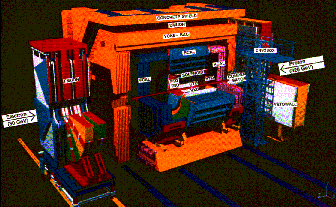| HERA |
| ZEUS |
| Tracking |
| Calorimetry |
| Next |
| Previous |
The ZEUS Detector
To try and figure out what is going on when two particles collide, large detectors have been built indentify and measure the particles produced in the collision. The ZEUS detector is one of several large experiments that make use of the electron-proton collision events provided by HERA. Particles from HERA are forced to collide in the centre of the ZEUS detector and the subsequently created or scattered particles pass through various sophisticated instraments that try to indentify them and measure their energies and momentia.
 |
|
At the centre of ZEUS is the central tracking detector which is the first component that the particles come into contact with, which has a negligible effect on the particles passing through it. Next are the calorimeters which absorb particles to measure their energies. The only particles to not be absorbed by the calorimeters are muons and neutrinos. The neutrinos are close to impossible to detect as they only interact via the weak interaction and the muon are then detected by the muon detectors outside of the calorimeters.